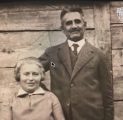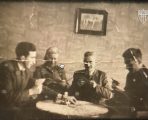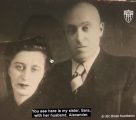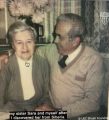- Local Survivor registry
- IRVING MENLOW
- Local Survivor registry
- IRVING MENLOW
Survivor Profile
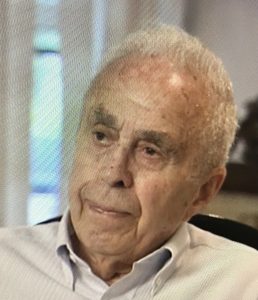
IRVING
MENLOW
(1915-2009)
PRE-WAR NAME:
ISRAEL MENDELOWITZ
ISRAEL MENDELOWITZ
PLACE OF BIRTH:
KRETINGA, LITHUANIA
KRETINGA, LITHUANIA
DATE OF BIRTH:
AUGUST 10, 1915
AUGUST 10, 1915
LOCATION(s) BEFORE THE WAR:
KRETINGA, LITHUANIA; KLAIPEDA, MEMEL; KOVNO (KAUAS), LITHUANIA
KRETINGA, LITHUANIA; KLAIPEDA, MEMEL; KOVNO (KAUAS), LITHUANIA
LOCATION(s) DURING THE WAR:
KOVNO GHETTO; SUTTHOF; DACHAU CONCENTRATION CAMP; DACHAU SATELLITE
KOVNO GHETTO; SUTTHOF; DACHAU CONCENTRATION CAMP; DACHAU SATELLITE
STATUS:
SURVIVOR
SURVIVOR
RELATED PERSON(S):
LEO (LIEB) MENDELOWITZ - Father (Deceased),
SARA (BESSA LEAH) MENDELOWITZ - Mother (Deceased),
WOLF MENDELOWITZ-BROTHER (Deceased),
ELIAS MENDELOWITZ-BROTHER (Deceased),
HARRY MENDELOWITZ-BROTHER (Deceased),
YITZAH MENDELOWITZ-BROTHER (Deceased),
SARA MENDELOWITZ-SISTER (Deceased),
JEAN MENLOW - Spouse (Deceased),
RAISA MENLOW - Spouse (Deceased),
DAVID MENLOW - Son,
ELAINE MENLOW - Daughter
-
BIOGRAPHY by Nancy gorrell ADAPTED from Shoah video, MAY 10, 2000
Biography Adapted by Nancy Gorrell from Shoah Video Testimony
Date: May 10, 2000
Interviewer: Dina Cohen
Place: Short Hills, NJ
Country: USA
Irving Menlow (Israel Mendelowitz) grew up in Kretinga, Lithuania in the 1920s and 1930s to a tightly knit, loving, and highly educated and successful Jewish family. His father, Leo (Lieb) was a prosperous businessman who cut trees and milled wood for cellulose companies manufacturing paper. His father also dealt in real estate. His mother was a housewife. Irving’s family lived in a house that he describes as “comfortable” decorated by his mother. When asked by the Shoah interviewer, “What was your mother like?” Irving replies, “Where do you start to describe a mother – the best is not good enough. Then he breaks down. He continues through tears –
“very caring, in those days we did not have maids… she had to do it herself and my father too… he sent three young kids to college …never heard her complaining…very, very, close very, very, warm, intelligent, sense of humor, and beautiful.” Irving grew up with five accomplished brothers and one sister who became part of the family business. He was the second youngest of his five brothers. The oldest brother, Wolf, became a Superior
Court Judge in Lithuania, an “extraordinary achievement for a Jew at the time” according to Irving’s testimony. His second oldest brother, Elias, along with his sister, ran the family business importing crystal and porcelain for all of Lithuania centered in the neighboring city of Klaipeda. Harry, his next brother, went to college and became a lawyer. His youngest brother was Yitzah. He testifies he was equally close to all his siblings. He did not know his grandparents and there was not much of an extended family.
Irving describes Kretinga as “a very cosmopolitan town of 5,000 people built in a square.” They were horses, automobiles, churches and synagogues and the town was “more advanced than other towns.” His family owned an automobile as well. Although Irving lived in Kretinga, he and his family went to Klaipea, a neighboring city for shopping and education. His sister and her family also lived in Klaipea. When asked about his Jewish education, Irving testifies in his Shoah video that he went to a Heder and was Bar Mitzvahed, “of course.” In school mathematics was his favorite subject. Afterwards, he went to a Lithuanian public school. All his friends were Jewish. He was involved in Jewish organizations like Betar and was a Maccabi instructor for exercise. He wanted to be a textile engineer, and after public school graduation, he worked for a year in a textile factory because college was not available at that time. Then the war came. When asked by the interviewer if he ever experienced fights or witnessed anti-Semitic violence, Irving testifies, “No.” Although he did recall anti-Semitism surrounding Passover and Easter time in Kretinga, but he did not witness it.
Irving then describes the coming of the war and the foresight of his family. “I drove to Klaipeda to get my sister who was living there with her family before the Germans came. We knew the Germans were going to take over Klaipeda. It was a German city in many ways. I luckily got them out.” Irving recalls it was either 1938 or 1939 but he was not certain. In June 1940 when the Soviet Union occupied the capital Kovno (Kauna) of Lithuania, the Mendelowitz family life was over. Irving’s parents stayed in Kretinga with their youngest son, Itzah. Irving’s sister and her family were sent to Siberia, separated from their families for decades. Irving’s oldest brother, the Superior Court Judge was on vacation in Switzerland. Irving and his brother Harry travelled together to the capital city of Kovno (Kaunas) looking for work. Irving got a job in a shoe factory for a while. Later he got an apartment in a Jewish area in the middle of the town. Irving testifies that Kaunas was a nice place to live and work in with many other Jews. A year later, Germany attacked the Soviet Union and on June 24, 1941 Kovno was occupied by German forces (Refer to Historical Notes). Irving testifies that his mother, father and youngest brother went into hiding in Kretinga and then were caught and killed by the Germans.
Irving and Harry and his brother Elias and his wife and family were rounded up and sent to the Kovno Ghetto (Refer to Historical Notes). Irving describes the ghetto as “primitive” –a “square area fenced off with barbed wire. There were no barracks but small rooms.” Irving and his brother Harry were assigned one room; Irving’s other brother, Elias, and his wife were assigned the other small room. They all had to wear the Star of David armbands designating their status as Jews. Irving testifies to the brutality and inhumanity of Kovno Ghetto – the lack of food, the starvation, the overcrowding, and the daily aktions – to the left, you died; to the right, you lived to work. Through tears, he recalls Elias’ wife who would give her meager food to others in her family, including himself, before she would eat. Irving testifies that the Germans “assigned” him the position of Jewish policeman of the ghetto. This position was designated by wearing a cap. Irving doesn’t recall what else he wore in the ghetto. Most importantly, this position was considered work and his uniform gave him the opportunity to move around the ghetto. Irving testifies in his Shoah video, “I didn’t know what made me do it. I still don’t know what made me do it.” One day he saw ladies who had helped him and his brother in the unsafe area. Irving went over there, made ladies line up, and marched them over to “the other side and they stayed alive. I didn’t know how I had the guts to do it.” Irving testifies being a policeman was a thankless job. He did not get any extra privileges, food, clothes or access to the German guards. He never talked to them. Irving testifies that the Jewish policemen helped the German guards communicate.
Irving was in the Kovno Ghetto until the Germans “closed it one day without warning. Irving testifies “we did not know where we were going. We were transported by railroad cars like cattle…We came at night, I remember, and it smelled like somebody was just burned…They had a place they burned people.” Irving and his brother had arrived at Stutthof. Irving testifies he never gave up hope that he would survive. Irving and Harry stayed in Stutthof for two days. Then he and Harry were transported to a satellite camp of Dachau for work. He testifies there were five or six satellite camps, but the main one he and Harry worked in was “Feldafing.” Irving and Harry worked as electricians. Irving testifies that they had better food and conditions there as workers. Yet they always had to return to the barracks in Dachau to sleep each night in straw bunk beds. Irving testifies that the “worse” experience for him was the morning and night “appell” where inmates were lined up and counted. “In the winter we used to go barefoot. To see people drop dead right there…you drop dead and life goes on if you can call it a life.” Irving said to the interviewer,” That is why we went to work –to get away from the barracks.”
Irving doesn’t know the time or day, but one night they heard planes and bombing overhead. The Americans were coming. The Germans started them on a “death march” from the camp. Irving testifies they marched in their camp uniforms with no food or water. Irving and Harry marched over bridges and saw American planes overhead. They were not bombed or injured but they were starving. He recalls trying to eat food retrieved from garbage cans and getting deathly sick. They marched somewhere near Feldafing. Finally, American soldiers came armed in jeeps and liberated them. It was sometime in May, 1945. After liberation, Irving and Harry struggled to find food they could eat without getting sick. It wasn’t until the American Distribution organization arrived with food and clothing that Irving and Harry were able to eat and recover. Irving also credits the help of other American Jewish organizations like ORT and UJA.
During the post war period, Irving settled in Munich. He got a job as a chauffeur working for the military government because he could drive a car. Because of his skill, intelligence, and acumen, he got himself assigned as the American Zone Maintenance Officer in charge of a fleet of cars. During the post-war years in Germany, Irving married Jean. He testifies in his Shoah video that he “always wanted to go to America.” Irving learned there was an opening to go to America, and more specifically, Newark, New Jersey. He didn’t know where Newark, NJ was but he immediately seized the opportunity, leaving Germany on May 1, 1949. Irving says at the end of his Shoah video, “Don’t ask me how I survived. I really don’t know.”
-
SURVIVOR INTERVIEW:
Refer to Biography Above Adapted from Shoah Visual Testimony
-
HISTORICAL NOTES:
KOVNO (KAUNAS)
Kovno (Kaunas) was Lithuania’s capital in the interwar period (1920-1939). The Jewish community numbered 35,000-40,000 – about a fourth of the city’s population – with tens of Jewish institutions, 40 synagogues, institutions of higher Jewish learning, especially the worldwide famous Slobodka Yeshiva, Yiddish and Hebrew schools, a Jewish hospital, Zionist organizations.
In June 1940 the Soviet Union occupied Lithuania and established a communist regime. A year later, Germany attacked the Soviet Union and two days later, on 24 June 1941, Kovno was occupied by German forces. Lithuanian nationals welcomed the German occupiers, seeing them as liberators from Soviet occupation. Local paramilitary groups were permeated with anti-Semitism, claiming among others that the Jews had been behind the Soviet repression of their country. Thus even before the Germans entered the city, Lithuanian mobs began to kill Jews. This was followed in the beginning of July by systematic killing by the Einsatzgruppen (the mobile killing units) and their Lithuanian auxiliaries. A ghetto was established in August, but over the next weeks the killing continued. On 29 October 1941 another 9,200 Jews were killed. A relative quiet reigned in Kovno until March 1943, when 1,800 babies, small children and old people were dragged out of their homes and killed in what became known as “the Children’s Aktion”. Some other Jews were deported to camps in Estonia. By that time Lithuanian enthusiasm for collaboration with Germany subsided, but hostility towards Jews and denunciation persisted.
In July 1944, with the advance of the Red Army, the ghetto was liquidated. The Jews were taken to the concentration camps of Dachau and Stutthof. As many as 2,000 Jews died in the ghetto while trying to hide from the perpetrators. The Soviet Army liberated Kovno on 1 August 1944. Of what had once been a bustling community only 2,000 Jews had survived.
Retrieved Yad Vashem 10/2023
-
Sources and Credits:
Credits
SSBJCC Holocaust Memorial and Education Center Adapted Biography of Irving Menlow by Nancy Gorrell from Shoah Visual History Foundation, May 10, 2000.
SSBJCC Holocaust and Memorial Center gratefully acknowledges Sara Wasserman, granddaughter, for use of Irving Menlow’s Shoah visual testimony.


